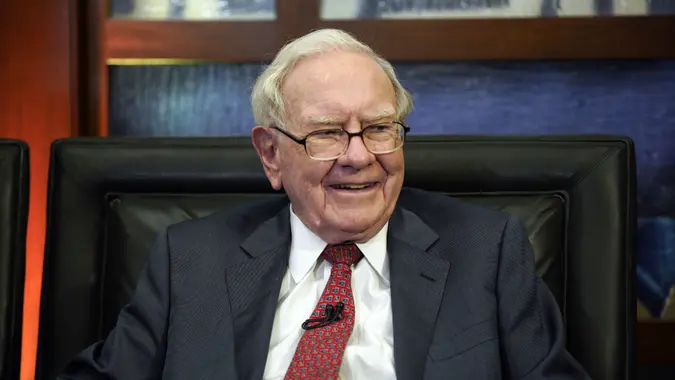How To Start Day Trading With $100

Commitment to Our Readers
GOBankingRates' editorial team is committed to bringing you unbiased reviews and information. We use data-driven methodologies to evaluate financial products and services - our reviews and ratings are not influenced by advertisers. You can read more about our editorial guidelines and our products and services review methodology.

20 Years
Helping You Live Richer

Reviewed
by Experts

Trusted by
Millions of Readers
Day trading became a social media sensation in 2021, when young investors took to Reddit, WhatsApp and other platforms hoping to get rich quick on speculative meme stocks like GameStop and AMC. While the craze has largely died down, many of those traders are still trading, and a new generation is itching to get started. But can you really day trade stocks with just $100? The answer is yes, but there are plenty of restrictions and restraints that come with it. Here’s what you need to know about starting to day trade with just $100.
See: 3 Things You Must Do When Your Savings Reach $50,000
Can You Really Start Day Trading With $100?
Technically, yes, you can start day trading with as little as $100. But you’ll have to understand the limitations and risks of trading with such a small bankroll. You’ll also need to go in with realistic expectations.
With just $100, it can be easy to lose your entire bankroll. A few bad trades — or even a single misstep — could wipe out your $100 in less than a day. And on the profit side, you shouldn’t expect your $100 to turn into $1 million. Even the best trader couldn’t earn a seven-figure bankroll starting with just $100.
However, there are some benefits to day trading with just $100. First, even if you get completely wiped out, it’s not a major loss. You can easily recover from losing $100 and living to trade another day. Another benefit is that trading with a small amount can help you learn how to develop trading strategies and systems, including profit targets and risk management, so that you have less to fear if you end up putting more capital at risk in the future.
There’s a huge caveat when it comes to day trading with $100, however, that could limit your success. If you make four or more day trades within five business days in a margin account, and those trades represent more than 6% of your total trades, you’re considered a “pattern day trader,” according to FINRA. With this label, you’ll be required to deposit at least $25,000 into your account, meaning your dreams of being a day trader with just $100 are over. However, you can avoid this situation by simply trading in a cash account, not a margin account.
Choosing the Right Brokerage
While you should always go with a low-cost brokerage firm if you’re going to be a day trader, it becomes absolutely critical if you’re only starting with $100. With such little capital invested, even a $1 fee amounts to a 1% rake on your profits. Find an online trading platform that offers commission-free trading and no account or maintenance fees so that you can keep all that you earn.
Before you even get off the ground, however, you’ll need to find an account that has a minimum deposit requirement of $100 or less. These days, most online brokerages have no minimum balance requirements, but if you plan on working with a traditional brokerage house, it might not be willing to open an account for just $100. Shop around a bit and you should be able to find a brokerage with no minimum balance requirements and no commissions or account fees.
Best Markets for Small Account Day Trading
Forex Trading
Forex trading can be a good option for day traders with $100 because it offers high leverage. If you bet correctly, you can earn many times your investment, helping you to boost your account value more rapidly. Forex trading, unlike stock trading, also offers a 24/7 market, allowing you full trading access at any time. And with forex trading, you can avoid the pattern day trader limitations.
Crypto Trading
Crypto trading, like forex trading, is notoriously volatile — perhaps even more so. While not for emotional traders, or those with a low risk tolerance, the volatility inherent in cryptocurrency, particularly with smaller or lesser-known tokens, can actually work to a day trader’s advantage. As with the forex market, crypto trading is open 24/7, giving an added layer of accessibility. As with forex trading, the pattern day trader rules do not apply to crypto trades either.
Stock & Options Trading
Most traders, particularly beginners, will likely be more comfortable trading the stock and options markets instead of forex and crypto. However, it should be noted that the pattern day trader rules do apply to stock and options trading, which can be a burden. Still, this might be offset by the familiarity that most investors have with the stock market vs. the forex and crypto markets. Trading in a volatile, unregulated market won’t do you much good if you don’t know what you’re doing. The stock market, on the other hand, can be a bit easier to decipher for beginning traders.
Essential Strategies for Trading With $100
There are three primary strategies that day traders use to make profits, and they’re relevant whether you have $100 or $1 million to invest:
Scalping
Scalping involves taking quick, small profits on frequent trades. For example, you might buy a stock for $10 per share and sell it for $10.05 in a matter of minutes or even seconds. If you repeat this process over and over, by the time the day is done you could end up with a handsome profit.
Momentum Trading
Momentum trading involves jumping into a stock and riding short-term price spikes. For example, if there’s a fever in the market for a particular stock and high-volume trading starts pushing its price up, you can ride that wave until the trend reverses. Identifying short-term momentum — and getting out before all your profits evaporate — is tricky business. But it can lead to significant profits in a short period of time for a successful day trader.
Breakout Trading
Breakout trading involves using chart patterns to determine when a stock moves past key levels. Once it breaks a downtrend and reverses up, this is the time for a trader to jump in. For example, if a stock has traded between $25 and $30 consistently for a year, as soon as it moves above $30, breakout traders will pounce on it.
A related strategy involves playing a stock’s trading range. Using the example above, where a stock consistently trades between $25 and $30 for a significant period of time, a trade might pick up shares as the stock approaches $25 and unload them as it approaches $30.
Risk Management Tips for Small Accounts
One of the dangers of day trading with a small amount of money is that you might get complacent and fail to implement a risk management system. Regardless of the size of your trading account, you should implement these risk management tips:
- Position sizing: The general rule among day traders is to never risk more than 1% to 2% of your capital on a single trade.
- Stop-loss orders: A stop-loss order gets you out of a losing trade at a specified price before it completely works against you and decimates your entire bankroll.
- Overtrading Although day traders almost by definition “overtrade,” you shouldn’t make day trades out of emotion or if you just “want to trade.” Instead, focus on quality trades that make sense based on your own personal trading system and methodology, and don’t stray into trades that don’t make the cut.
Tools & Resources To Get Started
Day trading can be difficult-to-impossible to master unless you’ve educated yourself and have some help along the way. Here are some of the tools and resources you can use to get started:
- Trading simulators: Even if you think you’ve got the markets figured out, it can pay huge dividends to test your strategies before you risk real money. As legendary boxer Mike Tyson once famously said, “everyone has a plan until they get punched in the mouth,” and this applies to day trading as well. You can use any number of free trading simulators to see how you do before you put any real capital into your account.
- Charting tools: No matter what type of day trader you’re going to be, you’re likely going to need to refer to charts to maximize your profits and minimize your losses. You can use free and low-cost charting tools online to help fine-tune your strategy.
- Educational resources: As the day trading community has exploded, so too have the educational resources available to traders. You can find numerous videos, books, and courses on day trading everywhere from online websites to your local library to a community college. The better informed you can be about how day trading works, the better your chances for success.
Steps To Start Day Trading With $100
If you’re ready to start day trading with $100, here are the steps you should take:
- Step 1: Choose a broker and open an account. Be sure to use a broker with no account minimums and no commissions for equity and ETF trades. You can find plenty of these online.
- Step 2: Select a market and strategy. Without a disciplined strategy for trading, you’ll soon run out of money no matter how lucky or good you are. Set upside profit targets and implement a strict risk management policy.
- Step 3: Practice with a demo account. By trading with paper money first, you can refine your trading strategies and see how they will work in the real world when you begin committing actual capital.
- Step 4: Start small and refine your approach. Even if you’re only going to start trading with $100, you shouldn’t just blow it all in one trade. Act as if that $100 is worth $100,000 in terms of your risk management approach. Start with the standard limit many day traders use of risking only 1% to 2% of your capital on any one single trade.
Our in-house research team and on-site financial experts work together to create content that’s accurate, impartial, and up to date. We fact-check every single statistic, quote and fact using trusted primary resources to make sure the information we provide is correct. You can learn more about GOBankingRates’ processes and standards in our editorial policy.
- Investor.gov. "Margin Account."
- Financial Industry Regulatory Authority. "Day Trading."
- Forbes Advisor. 2023. "A Basic Guide To Forex Trading."
- Benzinga. "How to Make Money on Forex Trading."
- IG. "Learn how to short a currency."
- CMC Markets. "Trading risk management."
 Written by
Written by  Edited by
Edited by 

























